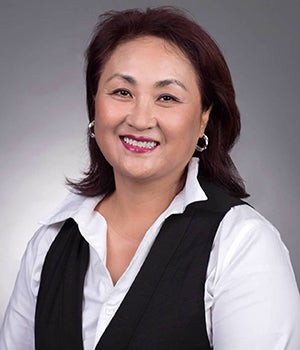Miyong Kim, PhD, RN, FAAN, wasn’t about to let the grass grow under her feet once she arrived at The University of Texas at Austin in 2013. Determined from the outset to make a difference in the burgeoning health inequalities that exist in Central Texas and across the state, the renowned nurse scholar and educator went to work and in less than a year had received National Institutes of Health funding for a P30 Core Center in Self Management of Chronic Illness.

As an internationally respected translational researcher, Dr. Kim is known for her community-based participatory research to reduce health disparities among traditionally underserved ethnic minority populations. Her research focuses on the key areas of hypertension and diabetes control, cancer prevention and mental health and has been continuously funded for many years.
The five-year NIH award for more than $2.3 million made possible the infrastructure necessary to facilitate trans-disciplinary collaborative research among investigators in nursing and other disciplines in order to improve self-management science. The resulting Center for Health Equity Research (HER) at UT Austin quickly began to tackle the issues by asking important questions about health equity and access, such as:
How can we move towards more equitable health care solutions?
Is it possible to foster an equitable benefit across patient populations of different socio-economic backgrounds?
How can we ensure that certain communities and populations won’t experience even wider health disparity due to a rapidly changing environment of advanced digital technologies?
Fortunately, she had come to the right place to find the answers.
Ranked among the biggest and best research universities in the country, UT Austin is home to more than 51,000 students and 3,000 teaching faculty, Austin, Texas, is a world-renowned technology hub, and the School of Nursing has managed two clinics in low-income, underserved areas for more than two decades.
Possessing both a broad knowledge of nursing education and research, but also specific strategies for meeting today’s health care delivery challenges, Dr. Kim and her staff have formed collaborations with other research faculty as well as government and community agencies.
“Dr. Kim led this truly collaborative effort that represented more than 40 faculty in 14 different academic units across the university,” Alexa Stuifbergen, dean of the School of Nursing, said. “They have intelligent, well-trained faculty and tons of ideas!”
Since its inception, the center has collaborated with local community health clinics to better understand what low-income residents are lacking, and several junior faculty have received funding for research projects anchored on the community’s needs.”
“We have a lot of underserved populations that are dealing with legal issues or low literacy,” Kim said. “It’s a really complex problem, and just one discipline is not going to be able to manage it. That’s why the Center for HER created a formal space for researchers of different disciplines — such as education, law, technology and business — to explore treatments tailored to the needs of underserved communities. Trans-disciplinary treatments can address the external factors influencing patients’ health.”
As technology continues to affect more and more Americans’ lives, it can also be integrated into patients’ treatment plans, she explained. The center researchers will collaborate with technology developers to create apps that make health publications more accessible for patients.
More recently the Center received grants from the City of Austin and the Michael & Susan Dell Foundation. The latter helped establish a Community Health Worker (CHW) Education Institute designed to help improve the quality of life and health outcomes of underserved populations. The Institute prepares lay health workers to focus on enhancing health and wellness and will help connect trained workers to paid positions in various community health systems. This initiative highlights the need for better reimbursement for these valuable community health services.
The Texas Health and Human Services Commission has become a partner on the CHW project and has provided the Center for HER access to its state-wide registry of these lay workers. Surveys have been distributed from which Dr. Kim hopes to find out more about their role definitions, job satisfaction and training needs.
“We regularly meet with our local and state partners to brainstorm policy implications and strategies. The real, true collaborative spirit we’re building with our multiple partners is something that gives me a lot of energy,” Dr. Kim said. “I want to continue to nurture that.”
The City of Austin grant was the result of a collaboration between community partners Mama Sana/Vibrant Woman and the Alliance for African American Health in Central Texas (AAAHCT) to design projects to address health care inequities. The partnership began when AAAHCT Executive Director Marva Overton attended a community-based participatory research class taught by Dr. Kim and Dr. Melissa Smith at the School of Nursing in spring 2015. The class brought together leaders of community organizations and graduate students to learn and practice how to design, implement, evaluate and disseminate community-based research through a true collaborative methodology. The two six-year health equity grants totaling more than $3 million were the first ever awarded by the city.
Austin has grown and prospered over the past several decades, but not all of its residents have benefited, Dr. Kim explained.
“Although several community organizations have long been involved in this struggle to right the wrong of health disparities, funding has always been a struggle. We are grateful to the Austin City Council for recognizing the barriers that many low-income individuals encounter as they try to obtain the health care they need and for providing the funds to help us help them overcome these barriers.”
And always at the center of all this effort and collaboration, Dr. Kim points out, is the patient.
“As nurses, we are culture and policy brokers. We bring the patient and health care provider perspective to the table. We’re all striving for the same result, but our partners don’t always understand the patient’s issues and concerns,” Dr. Kim said. “We bring that context. We are the translators, the bridge builders, between researchers, outside agencies, government and the community.”

